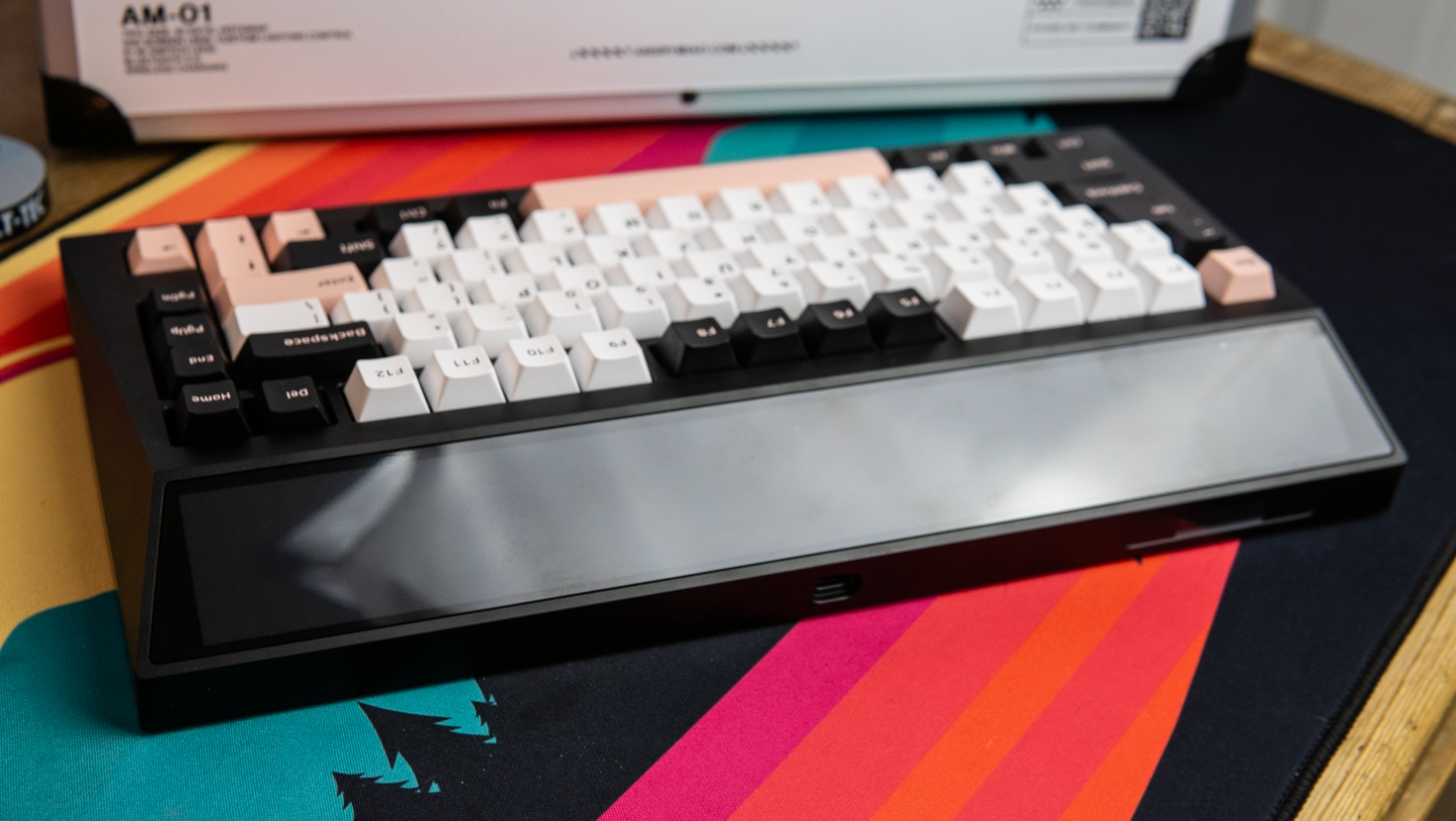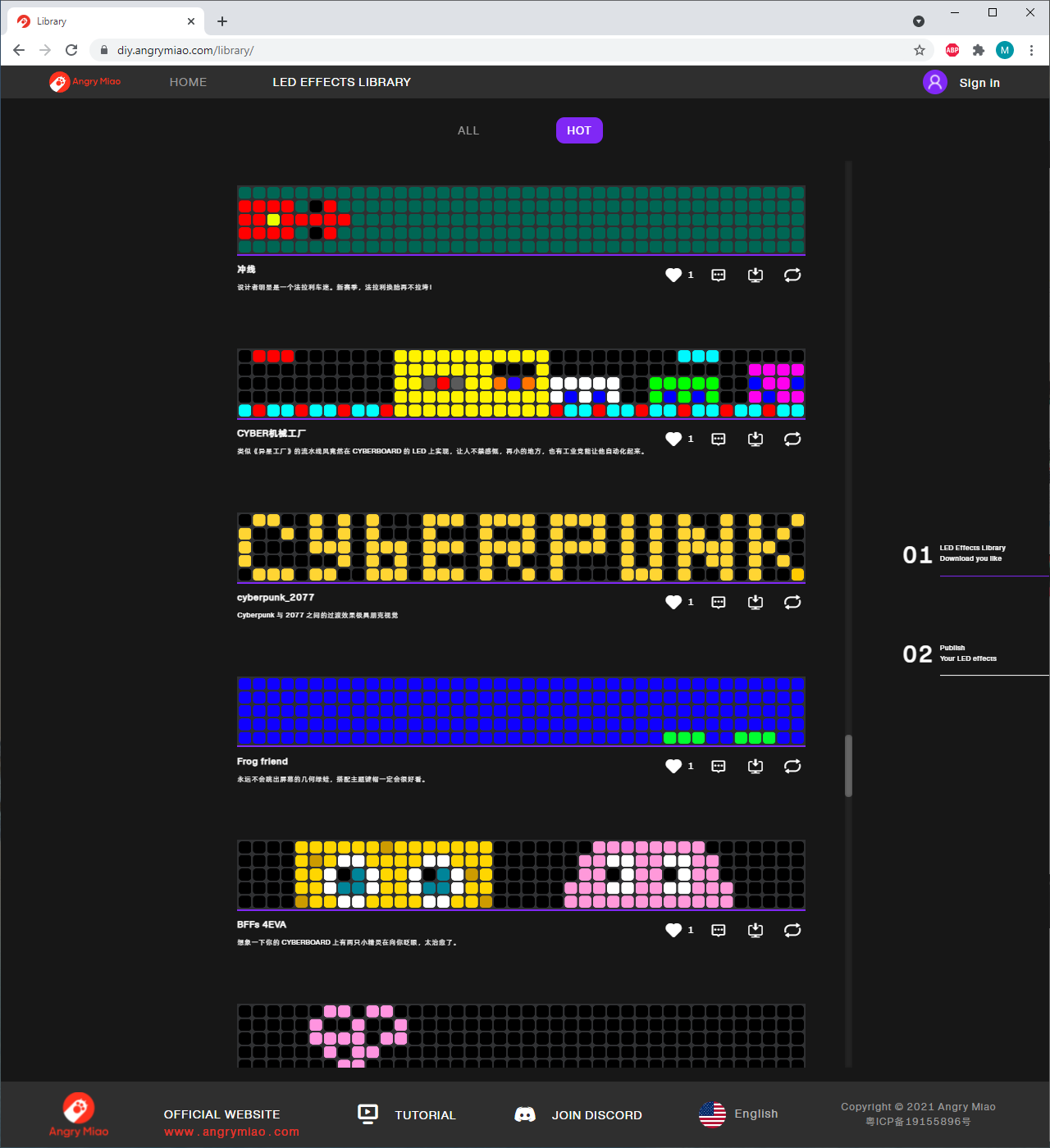Tom's Hardware Verdict
The Angry Miao Cyberboard R3 is in a league of its own when it comes to barebones mechanical keyboard kits because of its price and overall design. Even though the Cyberboard R3 is crafted beautifully, the price, Chinese-only software and volume control issues are a real kick in the face.
Pros
- +
+ LED panel
- +
+ Well-dampened
- +
+ Bluetooth
- +
+ Fully-aluminum
- +
+ Hot-swappable PCB
- +
+ Briefcase
- +
+ 5-pin support
- +
+ Surprisingly long battery life
Cons
- -
Very expensive
- -
Clock forgets what time it is
- -
Software is only in Chinese
- -
Volume Control is broken
- -
RGB is dim compared to bright LED panel
- -
Extremely heavy
Why you can trust Tom's Hardware
The word “cyber,” without a doubt, has become more and more prevalent in pop culture over the last few years, as seen in the popularity of the game Cyberpunk 2077, or the revival of the Blade Runner franchise. Founded in 2019, a small Chinese company called Angry Miao decided to capitalize on this cyber zeitgeist with the first Cyberboard, which was made to look like the Tesla Cybertruck and hit the mechanical keyboard community like a ton of bricks thanks to unique features like the huge 5 x 40 LED array on its backside. After two revisions, we now have the Cyberboard R3, which is a 75 percent gasket-mounted mechanical keyboard kit featuring hot-swap sockets, wireless charging, bluetooth compatibility, and of course, that big LED panel. While that all sounds amazing, especially the LED panel, this also comes with a hefty price of $570, and it doesn’t even come with stabilizers. Make sure you keep your other keyboard around because this one isn’t meant to be a daily driver because of its price and bulk.
Cyberboard R3 Keyboard
| Switches | N/A |
| Lighting | Non-addressable RGB |
| Onboard Storage | 3 LED Profiles, No adjustable RGB |
| Media Keys | Yes |
| Connectivity | USB Type-C |
| Cable | N/A |
| Additional Ports | N/A |
| Keycaps | N/A |
| Software | AngryMiao |
| Dimensions (LxWxH) | 343mm x 178mm x 51mm |
| Weight | 6.6 pounds |
Design




The design of the Cyberboard is inspired by the Tesla Cybertruck, which has a shape that I personally find to be absolutely brilliant. However, that design’s been around since this keyboard’s first generation. This third iteration expands on it with a color palette inspired by film director Wes Anderson’s most popular films.
For example, the four colors the Cyberboard R3 comes in have names like ”Budapest Pink, Aquatic Green, Cloud White and Asphalt Black.” To be honest, I find the choice to pair Wes Anderson’s aesthetic with Tesla’s to be a bit random. The difference between a movie like The Grand Budapest Hotel and a cybernetic-style keyboard is night and day, but that’s just me.
The review sample I received was the “Asphalt Black” model, which looks great. The finish is very clean, fits with the cyber theme and remains uniform in quality across the entire keyboard.
Even though mechanical keyboard enthusiasts swear by heavy keyboards, the Cyberboard R3 is extremely heavy even for the most dedicated mechanical keyboard fan. After installing stabilizers, switches and keycaps, the board weighed in at over six pounds (3kg), making it the heaviest keyboard I have ever used.
Along with being an absolute unit in weight, the Cyberboard R3 is overall bigger than most 75 percent mechanical keyboards, measuring in at 13.5 x 7 x 2 inches (343 x 178 x 51mm). The GMMK Pro for example is 13 x 5.25 x 1.25 inches (330 x 133 x 32mm).
Charging the Cyberboard R3 can be done in two ways, either via USB type-c or wirelessly. But wireless isn’t like with a phone, you instead need a special component. On the bottom of the case is a glass disk and inside is a little pad that’s wrapped in copper wire. This pad isn’t there to just look cool, instead, it’s there to connect to AngryMiao’s charging mat, called the Cybermat. This is sold separately and has an unknown price tag at the time of this review.
Get Tom's Hardware's best news and in-depth reviews, straight to your inbox.
Speaking of charging, this futuristic keyboard uses a 5000 mAh battery, which is enormous compared to the batteries we’ve seen in other barebones mechanical keyboards like the Epomaker GK108S. That keyboard’s battery has a 1600mAh capacity, and even that lasted long in between charges. With that said, even though the battery on the Cyberboard is much larger than any wireless keyboard I have seen, it didn’t feel like overkill because the last thing you want in a hefty keyboard like this is a small battery.
One of the Cyberboard R3’s best features is the battery indicator, which is displayed on the massive screen so you can’t miss it. The battery has a lot to power between three Bluetooth profiles, RGB and of course, the LED panel.
After I let the Cyberboard R3 charge overnight, I used it with the RGB enabled and the LED panel on. After about 35-40 hours of use, I was at 36 percent power, which is excellent.
To my surprise, the Cyberboard R3’s RGB is barely noticeable. I will say that I wasn’t using shine-through keycaps, but I didn’t use shine-through keycaps on the GMMK Pro either and I was able to see the RGB pretty well on that. Normally I wouldn’t care for RGB (if anything, I prefer not having it), but with a keyboard like the Cyberboard R3, I expected better RGB lighting, especially per-key RGB.
Unlike most and even the cheapest RGB mechanical keyboards, the RGB on the Cyberboard R3 is not adjustable and can only be changed to a few different modes, like the usual breathing rainbow, a weird mode that only lights up the “P” key, pass without a trace and one that makes the entire row of the key you entered light up.
Angry Miao says that it made changes to the Cyberboard overall, like the refresh rate of the LED panel, better color reproduction and seamless Bluetooth connectivity. While I don’t have any of the previous models of the Cyberboard, I will say that the Bluetooth connectivity is seamless. To enable Bluetooth, all you need to do is press Fn+1, 2 or 3, and boop, you’re connected.
Finally, the LED panel is extremely awesome, but its clock is practically useless. When I first cycled through the pre-installed effects, there were two presets that stood out to me. One looked like a game of Galaga and the other looked like a car was driving. When I think about it now, it would be cool to see if Angry Miao could make these effects interactive via the spacebar like the Google Chrome T-Rex Game, because they’re already animated.
The Cyberboard R3’s clock preset is inconsistent. There have been a handful of times where I would get home and see that the clock was hours and even minutes ahead.
Typically, we don’t talk about the packaging of products, but the Cyberboard doesn’t just come in a cardboard box: it comes in a metal briefcase. Inside the briefcase, you get the Cyberboard, some stickers, allen keys, some extra screws, and the scent of dead fish. I’m not kidding about that last one. I don’t know what happened, but the smell was so putrid I thought all the cilia in my nostrils were going to dissolve.
Assembly
Let’s talk about what comes in the box, because it’s not a lot for the price. The Angry Miao Cyberboard R3 is a 75 percent, gasket-mounted, hot-swappable mechanical keyboard kit that, unlike most barebones kits like the Epomaker GK108S or the Drop Carina, doesn’t even come with stabilizers.
For the $570 that you pay for the kit, you only get the PCB and the case. This meant I had to add on stabilizers, switches and keycaps. After I finished assembling the Cyberboard R3, the cost of the assembled board would have been around $730.
The Cyberboard R3 not coming with stabilizers also means you need to install them yourself. Fortunately, taking apart the board is as easy as can be, but you need to pay attention to the ribbon cables.
On the back of the PCB are two ribbon cables that connect to the daughterboard, and while all you need to do is flip up the tabs holding them in, it can be off-putting to some to have to tinker with the PCB. Besides that, it assembles like any other keyboard: screw in the stabilizers, put in the switches and then put the keycaps on top.
Typing Experience
Because the Cyberboard R3 is a barebones kit, you are in charge of what parts you want to pair with it. Because the board is so expensive, I decided to throw in some high-end parts. The parts I used were hand-lubed Durock Pom switches with 75g progressive springs, Durock V2 screw-in stabilizers and Akko Olivia keycaps.
I have tried this loadout before on other barebones kits, but never have I had such a nice typing experience with it as I did with this Cyberboard.
I loved typing with the Cyberboard R3; the gasket-mount implementation is very soft and the 10-degree typing angle is a bit steeper than I’m used to, but with my big hands it feels better than the usual six degrees like on the GMMK Pro.
Unfortunately, there isn’t a ton of flex when typing on the Cyberboard R3, but I can forgive it a bit because of how soft it feels when I bottom out. However, what I would like to see from Angry Miao is the option to purchase different plate materials, like FR4, polycarbonate or brass.
Just because I said that there isn’t much flex doesn’t mean that you can’t fix that. I did some modifications to the keyboard that I also did to the GMMK Pro to provide a more satisfying typing experience. In short, I removed the standoffs on the plate. By doing so, I gave the plate more room to move around.
Gaming Experience
I have been using Call of Duty: Black Ops Cold War as my game of choice for the most part in testing keyboards, but since this is the Cyberboard R3, I had to reinstall Cyberpunk 2077, because it only makes sense. Along with Cyberpunk 2077, I also booted up Observer, as it fits under that tree of games. There wasn’t much to test in regards to gaming, since this is a barebones kit. The switches I used, Durock Poms, also aren’t “gaming switches” but they did the job and I can see this keyboard fitting well on a desk that is accompanied by something like a Lian Li PC-O11 Air Mini.
Software




The Cyberboard R3’s software is probably the most disappointing thing about it, in that it’s not really anything at all. You can only officially edit key functions on Angry Miao’s website, and while it works like most keyboard layout editing software, I couldn’t change certain shortcuts like volume control, LED panel control, or RGB control. That’s a big issue, especially since the default volume controls are broken.
Previous generations of Cyberboard had the same volume control issue, so if Angry Miao hasn’t fixed the volume issue by now with the Cyberboard R3, that leads me to believe they won’t fix it at all in the near future. Basically, either the shortcut to adjust the volume wouldn’t work at all, or it would only increase the volume, no matter what volume control input I entered. This is extremely unacceptable, as I’ve never used a keyboard that couldn’t do simple volume control before. Fortunately, there is an unofficial fix, which you can find in our article on how to configure any key on your keyboard to perform a custom action.
The LED panel’s display can be customized and you can use designs created by other Cyberboard users on the Angry Miao DIY website, but doing so is a bit weird. When you pick what design you want to use, you need to download the .json file, then re-upload it to Angry Miao’s website, then download it again so the Angry Miao software can upload it to the Cyberboard R3.
Before you embark on the convoluted process of adding in a new LED effect, you’ll need to install the Angry Miao software, which looks like malware when you get to install wizard because everything is in Chinese.
Bottom Line
After using the Angry Miao Cyberboard R3 for over a month, I came to the conclusion I expected to have with the Cyberboard R3, in that it is targeted towards a very specific niche. As a keyboard enthusiast, I love having this keyboard because while it is not practical for everyday use or the non-enthusiast because of its price, it is fun to break out every once in a while because of how unique and good-looking it is, especially after knowing that it is safe in the included briefcase. The Cyberboard R3 is not perfect, but it is something special and different. The price of the Cyberboard R3 is steep and because of that, no wonder there are only 1,000 of them made.
So, do I recommend this keyboard? Yes, but don’t expect it to be the world’s greatest everyday keyboard or to perform like the ones on our Best Gaming Keyboards list. If you like to play with boards like I do, though, it’ll be a great addition to your collection— almost like a nice piece of new furniture.

Myles Goldman is a freelance writer for Tom's Hardware US. He reviews keyboards and cases.